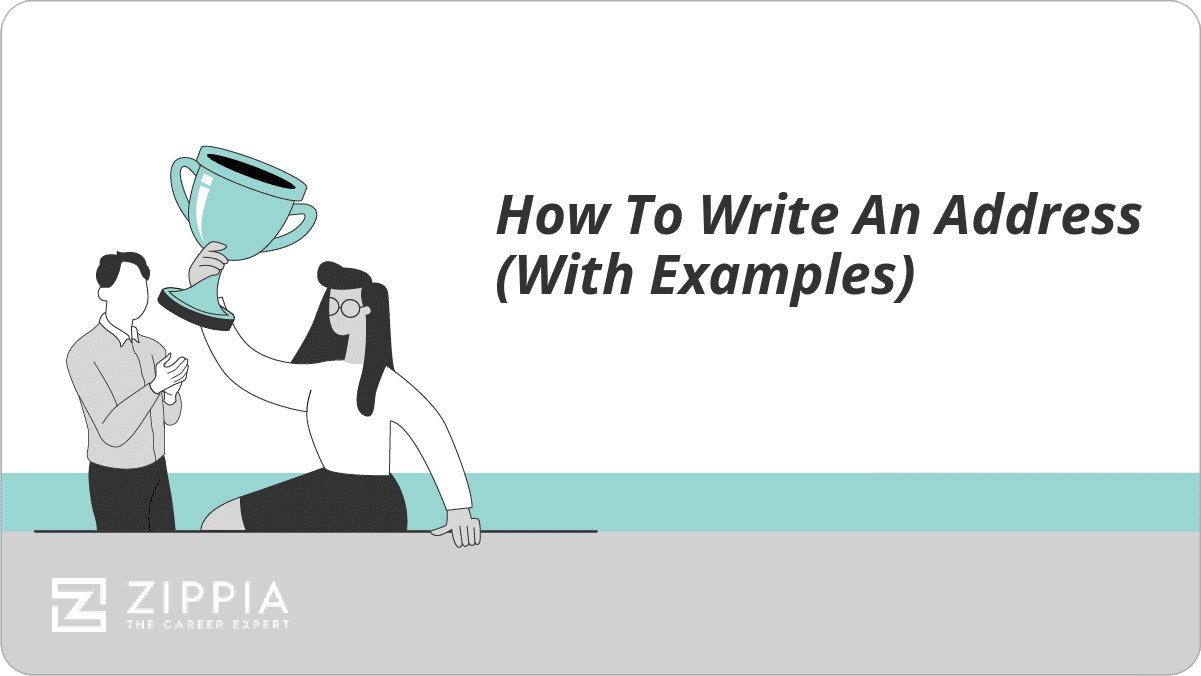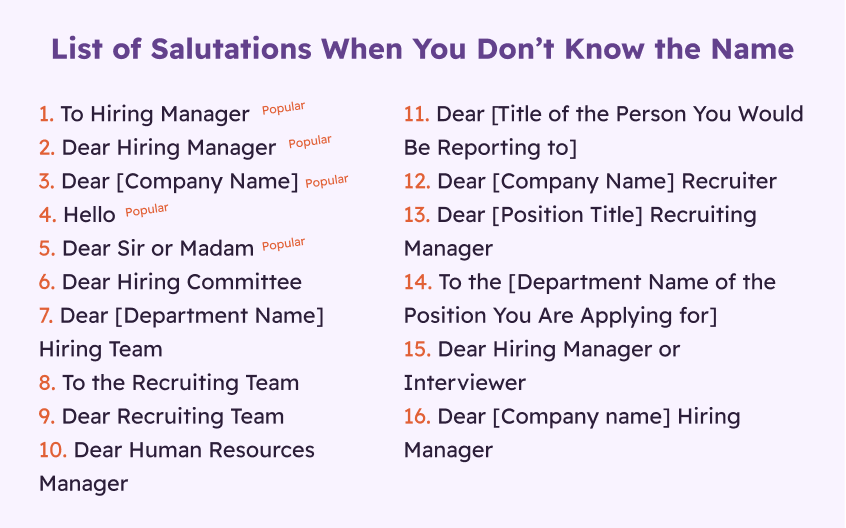20 Examples Of How To Address a Cover Letter to an Unknown Recipient
Introduction.
Imagine sending out dozens of job applications, only to realize that you've been addressing your cover letters incorrectly. As it turns out, addressing a cover letter to an unknown recipient can be a tricky task. In this comprehensive guide, we'll provide strategies for finding the right name, using job titles as an alternative, formatting the letter, avoiding common mistakes, leveraging professional networking, and understanding the importance of personalization. By following our advice, you can increase your chances of landing that job interview and making a great first impression.

Finding the Right Name
Before you give up on finding the recipient's name, consider these research strategies:
Check the job post for a specific name. Sometimes, the name of the hiring manager or contact person is listed in the job posting. Read the post carefully to see if a name is mentioned.
Search the company website for a company directory or listing of key personnel. Many organizations have a "Meet Our Team" or "About Us" section that introduces their staff members. Look for someone with a relevant title, such as "Hiring Manager" or "Human Resources Director."
Call the company directly and ask for the appropriate contact person. If you're unable to find the name online, consider calling the company and asking for the name of the person responsible for hiring for the position you're applying for. This approach can be particularly effective for smaller organizations.
Utilize professional networking platforms like LinkedIn to find the recipient. LinkedIn is a powerful tool for job seekers. Try searching for employees at the company with relevant titles, then check their profiles for clues about their role in the hiring process. You can learn more about how to find the name of the hiring manager using LinkedIn in this helpful article.
Personalize your cover letter. Addressing your cover letter to a specific individual shows that you've done your homework and are genuinely interested in the position. This extra effort can make a big difference in how your application is perceived by the recipient.
Using a Job Title
If you're unable to find the recipient's name, consider using a job title or department head as an alternative:
Address the letter to the job title of the reader. For example, you might write "Dear Hiring Manager" or "Dear Human Resources Director." This approach is more specific and professional than using a generic greeting like "To Whom It May Concern."
Consider addressing the letter to the head of the department where you're applying to work. If you know the department your job falls under, try addressing your cover letter to the department head, such as "Dear Marketing Director" or "Dear IT Manager."
Explain why using a job title or department head can still demonstrate professionalism and personalization. Although it's not as ideal as using a specific name, addressing your letter to a relevant job title shows that you've put some thought into your application and have a clear understanding of the company's structure.
Provide examples of different job titles to use as salutations. You can find a list of different job titles to use as salutations in this resource.
Discuss the potential impact of using job titles on the success of the job application. While using a job title may not guarantee success, it can increase your chances of making a favorable impression. A personalized salutation indicates that you're genuinely interested in the position and have taken the time to research the company.
Formatting the Letter
When addressing a cover letter to an unknown recipient, follow these formatting tips:
Always use "Dear" to start the address. This is a professional and respectful way to begin a cover letter.
Use a gender-neutral title (such as Ms.) if the recipient's gender is unknown. If you're unsure of the recipient's gender, it's better to use a neutral title like "Ms." rather than making assumptions.
For non-gender-specific names, use the recipient's full name. If you can't determine the recipient's gender based on their name, address the letter using their full name, such as "Dear Taylor Smith."
Maintain a professional tone even when the name is unknown. Even if you don't know the recipient's name, it's crucial to keep your language and tone professional throughout your cover letter.
Provide examples of well-formatted cover letter salutations.
While it's always best to try and find the name of the hiring manager or recruiter, there may be times when you just can't find that information. Don't let it deter you. Below are 20 examples of how you can address your cover letter when the recipient is unknown:
1. Dear Hiring Manager, 2. To the Recruitment Team, 3. Dear Human Resources Team, 4. Attention Hiring Committee, 5. Dear [Job Title] Hiring Team, 6. To the [Company Name] Team, 7. Dear [Company Name] Recruiter, 8. To Whom It May Concern, 9. Dear Hiring Authority, 10. Attention [Company Name] Hiring Professionals, 11. Dear Talent Acquisition Team, 12. Hello [Company Name] Selection Panel, 13. Dear Recruitment Advisor, 14. To the [Industry] Professionals at [Company Name], 15. Attention [Company Name] Talent Scouts, 16. Dear Hiring Advocate, 17. To the Selection Committee for [Job Title], 18. Dear [Company Name] Staffing Team, 19. Attention [Job Title] Recruitment Panel, 20. Dear [Company Name] Hiring Panel,
Remember, the goal is to be as respectful and professional as possible in your salutation. Even if you don't know the recipient's name, demonstrating courtesy in your greeting will set a positive tone for the rest of your cover letter.
Also, avoid overly casual greetings like 'Hello' or 'Hi there,' which might seem unprofessional, and stay clear of outdated phrases such as 'Dear Sir or Madam.' Instead, opt for more modern, inclusive alternatives. Be sure to follow your greeting with a comma or a colon, then leave a space before starting the body of your letter.
Avoiding Common Mistakes
When addressing a cover letter to an unknown recipient, it's essential to avoid these common mistakes:
Using generic greetings like "To Whom It May Concern." This phrase is outdated and impersonal, and using it can make your application seem generic and unprofessional. Instead, try to find a specific name or use a job title, as discussed in previous sections.
Using incorrect titles or making assumptions about the recipient's gender. Making assumptions about someone's gender or using an inappropriate title can potentially offend the recipient and hurt your chances of landing an interview. Stick to gender-neutral titles or use the recipient's full name when in doubt.
Addressing the letter to the wrong department or job title. Be sure to double-check that you're addressing your letter to the appropriate person or department. Sending your application to the wrong person can result in your application being overlooked or discarded.
Failing to proofread the cover letter for errors, even in the salutation. Typos and other errors can make a poor impression on the recipient. Be sure to proofread your entire cover letter, including the salutation, before submitting it.
Provide examples of mistakes that could hurt the applicant's chances of landing an interview. Some examples of common errors include misspelling the recipient's name, using an informal greeting (such as "Hey"), or addressing the letter to an unrelated department (e.g., "Dear Accounting Manager" when applying for a marketing position).
Utilizing Professional Networking
Leveraging your professional network can be an effective way to find the name of the recipient for your cover letter:
Use platforms like LinkedIn to research the company and its employees. As mentioned earlier, LinkedIn is a valuable resource for job seekers. You can use the platform to find employees with relevant titles, learn more about the company culture, and even discover mutual connections who might be able to provide an introduction or additional information.
Connect with current employees or alumni of the company. Networking with people who work at the company or have worked there in the past can give you valuable insights into the hiring process and help you identify the appropriate contact person for your cover letter.
Search for the appropriate contact person within your professional network. Use your connections to find people who work at the company you're applying to, and ask if they know who the hiring manager for your desired position is.
Networking can help job seekers get noticed by potential employers. Building relationships with people at the company can increase your chances of getting noticed and potentially even lead to a referral. Learn more about how networking can help job seekers get noticed by potential employers in this article.
Offer examples of successful job seekers who found the recipient's name through networking. For instance, this cover letter that landed a job seeker a role at LinkedIn is a great example of how personalizing your cover letter and leveraging your network can help you stand out.
Importance of Personalization
Personalizing your cover letter can make a significant difference in the success of your job application:
Discuss the impact of personalization on the reader's impression of the applicant. A personalized cover letter demonstrates that you've done your research and are genuinely interested in the position, which can make a positive impression on the recipient.
Provide statistics on the success rate of personalized cover letters compared to generic ones. According to resume statistics , candidates with typos in their cover letters or resumes are 58% more likely to be dismissed, while those who do not include specific employment dates are 27% more likely to be dismissed.
Offer expert opinions on the importance of addressing cover letters to specific individuals. Many career experts agree that addressing cover letters to specific individuals can increase your chances of landing an interview.
Explain how personalization demonstrates research skills and genuine interest in the company. Taking the time to research the recipient and tailor your cover letter to the specific position and company shows that you're not only a thorough and detail-oriented candidate, but also genuinely interested in the opportunity.
Share anecdotes of successful job seekers who personalized their cover letters and landed interviews. For example, one job seeker found the recipient's name through LinkedIn and personalized his cover letter , which helped him land an interview and ultimately secure the position.
Conclusion and Final Thoughts
In summary, addressing a cover letter to an unknown recipient can be challenging, but by following our tips and strategies, you can make a strong impression on potential employers. Remember to:
- Research the recipient's name or use a relevant job title.
- Personalize your cover letter to demonstrate genuine interest in the position.
- Maintain a professional tone and formatting throughout your cover letter.
- Avoid common mistakes that can hurt your chances of landing an interview.
- Leverage your professional network to find the appropriate contact person.
By applying these tips to your job search, you'll increase your chances of success and make a lasting impression on potential employers. Good luck with your job applications!

6 Examples: How To Address a Cover Letter Without a Name
By Status.net Editorial Team on December 25, 2023 — 11 minutes to read
Addressing the recipient without knowing their name might seem complicated, but there are ways to navigate this situation. Let’s take a look at a few strategies to make your cover letter feel personalized even when you don’t have a specific name to address.
Be Professional and Engaging
Using general salutations like “To Whom It May Concern” or “Dear Sir/Madam” can make your cover letter feel impersonal. Instead, opt for a more engaging opener such as “Dear Hiring Manager” or “Dear [Company Name] Team.” This type of greeting acknowledges the company and shows that you have researched the team you are addressing.
Focus on the Position and Company
Make sure to tailor the content of your cover letter to the job you are applying for by highlighting relevant qualifications, experience, and skills. Share specific examples of your successes that align with the responsibilities of the position. Mention the company’s values, goals, or recent successes to demonstrate how your values align with theirs. This can effectively showcase your interest and commitment to the role.
Use LinkedIn and Company Website Research
If you cannot find the hiring manager’s name in the job posting, you can turn to LinkedIn or the company website for clues. Search for professionals working in human resources or hiring roles at the company. If you find a specific contact, address your letter to that person while using their full name and title. Otherwise, continue with a professional and engaging salutation as mentioned earlier.
Here are two examples of how to start a cover letter without a name:
Dear Hiring Manager, As a passionate marketer with five years of experience, I am excited to apply for the Marketing Manager position at (…) Company. Achieving a 30% increase in leads generated through my previous campaigns, I am eager to contribute to the growth of your marketing department.
Dear ABC Inc. Team, With a strong background in project management and a proven track record of implementing cost-saving strategies, I am confident in my ability to excel as the Senior Project Manager at ABC Inc. Your company’s commitment to sustainable practices aligns with my values and I am thrilled to be considered for this opportunity.
By applying these strategies, you can create an impactful and personalized cover letter, even without knowing the recipient’s name. This attention to detail can set you apart from other applicants and leave a positive impression with your prospective employer.
How to Find the Hiring Manager’s Name
Sometimes locating the hiring manager’s name can be tricky, but there are several ways to find it. Let’s go through a few methods to help you address your cover letter without a name.
Using LinkedIn
LinkedIn is a great resource for finding the hiring manager’s name. Here’s how you can use it:
- Visit the company’s LinkedIn page.
- Click on the “People” tab to browse through the employees.
- Use the search bar and enter keywords such as “recruiter,” “hiring manager,” or the department you’re applying to.
- Check the found profiles, and try to identify the right person responsible for hiring in your desired role.
Make sure to double-check that the person is currently working in the company to avoid using outdated information.
Checking Company Website
Another way to find the hiring manager’s name is by checking the company website:
- Locate the “About Us” or “Team” page, where you might find a list of employees along with their titles and roles.
- Look for a person who has a recruiting or hiring-related title within the department you’re targeting with your application.
- If you cannot find the necessary information on the website, try checking a company’s press releases or blog. Sometimes they include names of important team members.
Making a Phone Call
When all else fails, you’re left with one more option – making a phone call.
- Call the company’s main line and politely ask the receptionist for the name of the hiring manager or the person responsible for recruitment in the department you’re interested in.
- Be prepared to provide the job title and a job reference number (if available) to help the receptionist find the right person.
Finding the hiring manager’s name isn’t always possible. If you cannot locate it, don’t worry. Addressing your cover letter as “Dear Hiring Manager” or “To Whom It May Concern” is still better than not sending a cover letter at all.
How To Address a Cover Letter Without a Name: Sample Phrases
Starting with job title.
When you cannot find the recipient’s name, use their job title to address the cover letter. This shows that you can connect and direct your message to the relevant person. Here are some examples:
- Dear Hiring Manager, – This is a common and universally understood phrase for addressing a cover letter without a name.
- Dear [Job Title], – Use the specific job position that the recipient holds, for instance, Dear Marketing Director .
- To the [Job Title] Selection Committee, – This approach can be useful when applying for a role advertised by a team or committee that will handle the hiring process, such as To the Scholarship Selection Committee .
Referring to Department
Another approach is to address the cover letter to the department that the position is within. This helps to direct your message to the appropriate team or group. Here are some examples:
- Dear [Department] Team, – Mention the department you are applying for, such as Dear HR Team, or Dear Sales Team .
- Greetings, [Department] Department, – Use the department name to address the letter, like Greetings, IT Department .
- To Whom It May Concern in the [Department], – This is a formal alternative when you don’t know the recipient or department’s name, for example, To Whom It May Concern in the Finance Department .
Using these approaches will ensure that your cover letter appears professional and well-directed, even when you don’t have the exact name of the recipient. Focus on the content and the skills you bring to the position to make the best impression on the reader.
Crafting Content for Cover Letters
When you’re unsure of the recipient’s name, you might feel a little lost on how to address your cover letter. Don’t worry. You can still create an engaging and professional cover letter that gets the job done. Here are some tips and examples to help you craft the perfect content for an anonymous cover letter.
Start with a professional, yet friendly, greeting. If you don’t know the hiring manager’s name, use a general opening line such as “Dear Hiring Manager” or “To Whom It May Concern” . These greetings are widely accepted and show respect towards the person receiving the letter.
Next, dive into your strengths, skills, and achievements. Mention the qualifications that make you a strong candidate for the position. Share relevant accomplishments from your previous roles, such as leading a successful project or boosting sales. Be specific when describing your skills and use quantifiable results when possible. For example:
“During my time at Company (…), I managed a team of 10 and successfully increased sales by 25% within six months.”
Show enthusiasm for the job and demonstrate your knowledge of the company. Research the organization’s goals, values, and recent projects, then incorporate this information into your cover letter. This will help you tailor your letter to the company’s needs and show that you’d be a good fit for their culture. You could say something like:
“As a long-time admirer of your company’s commitment to sustainability, I’m excited about the opportunity to contribute to the upcoming eco-conscious product line.”
Close your cover letter with a strong call-to-action. Express your interest in further discussing your qualifications and offer your availability for an interview. Thank the hiring manager for considering your application and include your contact information. A sample closing paragraph could look like this:
“I’m eager to discuss how my expertise in digital marketing could contribute to the success of your team. Thank you for considering my application. You can reach me at (555) 555-5555 or [email protected] to schedule a conversation.”
Keep your cover letter concise and focused on your unique selling points. Even without knowing the recipient’s name, following these guidelines will allow you to create a memorable and attention-grabbing cover letter that leaves a lasting impression on potential employers.
Tips on Prefix Usage
When you’re addressing a cover letter without a specific name, it’s good to think about the appropriate prefix to use. Here are some tips to help you choose the right one:
First, consider using a general and gender-neutral prefix like Dear Hiring Manager . It will work well if you don’t know the recipient’s name or aren’t aware of their gender. This is a widely accepted way to address a cover letter without a specific name.
Dear Hiring Manager, I came across your job posting for a Graphic Designer, and I am excited to apply for the role.
If you happen to know the job title of the person who will read your cover letter, you can use it. This shows that you have put effort into researching the company and position.
Dear Marketing Director, I am writing to express my interest in the open Digital Marketing Specialist position at your company.
In some cases, you might know the name of the department that the job is in. In this case, you can address your cover letter to the entire department.
Dear Finance Team, I was thrilled to see an opening for a Financial Analyst at your company and would like to apply for the position.
When you’re unable to find any specific details or when addressing a larger company, you can opt for a broad salutation like To Whom It May Concern . Just be aware that it may come off as impersonal, so it’s best to use this as a last resort.
To Whom It May Concern, I am submitting my application for the Content Writer position posted on your careers website.
The key is to maintain a professional tone throughout your cover letter. Regardless of which prefix you choose, always customize your content to suit the specific job and company you’re applying to. By doing so, you demonstrate a genuine interest in the role and leave a positive impression on the hiring manager.
Common Mistakes to Avoid
Sending a cover letter without addressing it to a specific person can be a pitfall. It might make the recipient feel unimportant or signal that you didn’t do your research. To make your application stand out, be mindful of these common mistakes:
- Not being specific about the role: Your cover letter should not only address the person but also the specific role you’re applying for. Tailor your letter according to the job and the company. For instance, instead of writing “I wish to apply for the marketing position”, be more specific like “I am interested in applying for the Digital Marketing Specialist role at [CompanyName].”
- Focusing too much on yourself: Although your achievements are important, the cover letter should focus on how your skills can benefit the company. Frame your accomplishments in a way that highlights the value you can bring to the organization.
- Being overly formal or stiff: While it’s important to maintain a professional tone, being too formal might come across as insincere or impersonal. Use a friendly tone and avoid jargon or buzzwords to keep your cover letter genuine and relatable.
- Spelling errors and typos: Even the smallest of typos can create a negative impression. Double-check your cover letter to make sure there are no mistakes. Keep an eye out for incorrect spellings, especially when addressing the recipient.
The goal of your cover letter is to make a personal connection and showcase how you are a great fit for the company. Taking the time to address your letter properly, proofread for errors, and customize your content demonstrates your attention to detail and commitment to the position.
Frequently Asked Questions
How can i properly address a cover letter when the recipient’s name is unknown.
If you don’t know the recipient’s name, consider using a general salutation instead. For example, “Dear Hiring Manager” or “Dear Recruitment Team” acknowledges the recipient without using a specific name. You can also research the company’s website or LinkedIn to try to find the appropriate contact person.
What alternatives are there to ‘To Whom It May Concern’?
There are several alternatives to ‘To Whom It May Concern’ that can help make your cover letter stand out:
- Dear Hiring Manager
- Dear [Company] Team
- Dear [Department or Job Title] Hiring Team
- Dear [Company] Recruitment Team
How do I determine the appropriate salutation for my cover letter?
To determine the right salutation for your cover letter, do a bit of research on the company or organization you’re targeting. This may help you uncover the specific department or hiring manager’s name. If not, use one of the general salutations mentioned earlier to address your cover letter in a more personalized manner.
What are examples of cover letter openings without using names?
Here are some examples of cover letter openings without using specific names:
- “Dear Hiring Manager, I am excited to submit my application for the [Job Title] position at [Company].”
- “Dear [Department or Job Title] Hiring Team, As a passionate professional with experience in [Industry], I am eager to contribute to [Company] as a [Job Title].”
- “Dear [Company] Team, I recently came across the [Job Title] opening at [Company], and I am confident that my skills and experience make me a strong candidate.”
How can I avoid common mistakes when addressing cover letters without names?
To avoid mistakes when addressing cover letters without names, follow these tips:
- Do thorough research on the company and the job posting
- Be concise and professional in your language
- Use an appropriate general salutation if you can’t find a specific name
- Double-check for spelling and grammatical errors before sending the cover letter
- Avoid using outdated or overused phrases, such as ‘To Whom It May Concern’ or ‘Dear Sir/Madam’
By following these guidelines, you can create a strong and effective cover letter that stands out to hiring managers, even if you don’t have a specific name to address.
- How to Send an Email Cover Letter (Examples)
- Resume vs. Cover Letter (Thoughtful Tips)
- 3 Administrative Assistant Cover Letter Examples (Guide)
- How To Write a Cover Letter [Inspiring Examples]
- Cover Letter vs. Letter of Interest vs. Letter of Intent
- 2 Smart Examples: Executive Assistant Cover Letter
- Knowledge Base
- Free Resume Templates
- Resume Builder
- Resume Examples
- Free Resume Review
Click here to directly go to the complete cover letter without name sample
How to address a cover letter without a name?
According to a study, every corporate job opening gets roughly 250 resumes , out of which only 3-4 applicants land an interview.
That means if your cover letter feels generic and lacks personal touch, it may end up in the trash.
However, what if there is a circumstance for addressing a cover letter with no name?
Read on to get an insight into the following FAQs:
- How do you write a cover letter if you don't know the hiring manager?
- How to format the cover letter address correctly?
- Who to write a cover letter to without a contact?
- Which method of delivering a cover letter is not appropriate?
- What are the practical ways to find the hiring manager’s name?
- Additional tips to write a cover letter without name
Whom to Address a Cover Letter To?
Who do you address a cover letter to when there is no name?
To understand how to address a cover letter, you need to know to whom to address it.
A cover letter should be addressed in the following ways:
- If the hiring manager’s name is given in the job description, you should always address the cover letter to them.
- If the hiring manager’s email address is not there in the job description, you can address the cover letter to the department manager.
There is no point in sending the cover letter to the CEO or founders because they are not the ones who usually handle the recruitment process.
Also Read: How to address a cover letter?
How to Address a Cover Letter Without a Name?
A cover letter for a job is not similar to a letter to a friend.
The purpose of a cover is to impress the hiring manager with your professional expertise to score an interview.
But addressing cover letters with no name may get rejected by the recruiters.
We understand how important it is to know how to write a cover letter without a name as per these statistics.
Also Read: How to write a cover letter?
Here are some steps on how to address a cover letter without a name:
1. Address the Cover Letter with “Dear Hiring Manager”
It is the most common way to address a hiring manager with no name and hiring managers prefer this salutation over no salutation at all.
This salutation allows the hiring manager to quickly focus on the main body of the cover letter, instead of rejecting the cover letter right away.
However, the best way to address a cover letter is by personalizing it.
2. Address the Cover Letter to the Team
When in doubt, you can address the whole team so that anyone from the team can receive your cover letter and respond accordingly.
It can be the hiring manager, assistant, or anyone from the department who may interview you during the job application process.
You can phrase it as:
- Dear Recruiting Team
- Dear Project Manager Hiring Team
Also Read: What can a cover letter explain that a résumé cannot?
3. Maintain Professional Approach
Maintain a professional approach and avoid informal phrases or words such as "Hello!", "Good Evening/Morning", or "Hi!"
Keep it simple and professional by using the term, "Dear" followed by the designation.
For Example:
- Dear Hiring Head
- Dear Recruitment Supervisor
4. Do Not Assume Gender or Marital Status
You often know the hiring manager’s name but do not know their gender or marital status.
Assuming someone's gender may seem disrespectful and unprofessional hence you should avoid making such mistakes by keeping it gender-neutral. Avoid the term "Sir" or "Madam" and simply address the recipient as "Dear (Profile)".
The best way to find the hiring manager’s gender is by doing a quick LinkedIn search.
The LinkedIn profile may contain a profile picture wherein you can determine the hiring manager’s gender.
If the hiring manager’s gender is Male, address the hiring manager with “Mr.”.
- “Mr. Xavier,”
If the hiring manager is female, it can be confusing.
As you don’t know the marital status, avoid using Miss. or Mrs. to address the hiring manager. Instead, use a generic “Ms..”
- Dear Ms. Moore
- Dear Ms. Kyle
- Dear Mrs. Lane
- Dear Miss Maximoff
Also Read: How to reach out to recruiters on LinkedIn?
5. Include Job Profile and Professional Titles
Are you asking yourself continuously, “How to address a cover letter without a contact name?”
Here is the answer for you.
Instead of using only “ Dear Hiring Manager ,” include the department name or the title of the person who will be reading the cover letter to make it more specific.
- Dear Marketing Department,
- Dear Head of the Sales Department,
- Dear VP of Marketing
By personalizing the addresses in this way, you can grab the hiring manager’s attention to read your resume.
This shows that you are not throwing a rock blindly. You have done your research and have some idea about the company.
Don’t forget to include the hiring manager’s academic title or professional title in the cover letter address.
These types of hyper-personalization can grab the hiring manager’s attention even more and entice them to read your cover letter.
How to Write the Academic Title in the Cover Letter Address?
You can write the academic title in full form.
- Dear Doctor Green,
- Dear Professor Geller,
Alternatively, you can use the abbreviation of the titles as well.
- Dear Dr. Murphy,
- Dear Prof. Goodwin,
- Dear Sgt. Moore,
- Dear Principle Alan,
Where to Place the Cover Letter Address?
Not just the proper format, but the placement of the cover letter address also plays an important role.
- The cover letter heading will go at the top.
- Write the date below the heading.
- Leave one line space and write the hiring manager’s name.
- Write the address of the company.
- Leave one space and then write the position you are applying for.
- Leave one space and then write the salutation.

Best Way to Address a Cover Letter with No Name or Email
Writing an email cover letter address is fundamentally similar but with some tweaks.
If you are sending a digital cover letter, you need to start with a professional subject line.
John Doe: Application for Video Editor Position, Reff: Anthony Moore
Then add your cover letter salutation based on the same rule.
Add a line space and then start your cover letter by adding the necessary information that gives an insight into your professional experience and skills.
Subject Line: John Doe: Application for Project Manager Position, Reff: Charles Moore
Dear Hiring Manager,
I am a 5+ years experienced project management professional…
Appropriate Method of Delivering a Cover Letter
- Dear Hiring Manager
- Dear Hiring Committee
- Dear (department name) Hiring Committee
- Dear Hiring Team
- To the (department name) Hiring Manager
- Dear Team (For smaller companies)
- To the Recruiting Team
Also Read: What are the benefits of using a cover letter builder?
Inappropriate Method of Delivering a Cover Letter
- Dear Sir or Madam — Ancient salutation does not work anymore
- To Whom It May Concern — It is not personalized
- Hello, Hi, or Greetings — Informal salutation
- Happy Sunday! — Casual salutation
- Good Morning — Not practical as you have no idea when they will read the letter
Also Read: How to draft a professional message to the hiring manager?
How to Find the Hiring Manager's Name?
How do you write a cover letter if you don't know the name?
Well, you can simply address your cover letter as, "Dear Hiring Manager". But if you feel the need to add the name of the hiring manager then there are ways to do so.
Finding the hiring manager’s name is the best way to address a cover letter.
So, before calling it quits, let us look at some ways to find the hiring manager’s name.
Read the Job Description Thoroughly
Always read the job description carefully!
Usually, the hiring manager’s name or the title of the reporting manager is given in the job description or under the job description.
For instance, “ The digital marketer will report to the Marketing Manager. ”
You can use the title to then find their name on the company website or LinkedIn.
Sometimes the job description includes the hiring manager’s email address.
For Example: “ Send your cover letter and resume to johndoe@hiration[dot]com" .
You can find the hiring manager’s name in the email address.
Visit the Profile of the Job Publisher
Sites like LinkedIn or AngelList have this unique feature to show you the name of the one who posts the job.
You can go to their profile to see if they are the hiring manager and include their name in the cover letter.
Call the Company Front Desk
Calling the company is the easiest way to find the hiring manager's name. But, job candidates reserve it as the last option.
- Call the company desk
- Tell them that you are applying for a “vacant position” in their company and would like to know the hiring manager’s name.
Here’s an example of the script:
“ Hi, my name is Alex, and I’m currently applying for the video editor position in your company. Would it be possible for you to provide me the name and email id of the hiring manager so that I can address the cover letter properly?”
Do a Quick LinkedIn Search
According to a study, 87% of recruiters use LinkedIn regularly . That means, if you search for the hiring manager of a certain company on LinkedIn, there is a high chance for you to find their name.
Many job descriptions specifically tell the reporting manager’s title in the job description. Then you need to address the cover letter to the reporting manager.
The process of finding the reporting manager’s name is similar.
- Go to LinkedIn
- Search the job title and company name
- In the search result, you can find the profile of the designated person
- Sometimes, there might be more than one similar position for a big company so you need to narrow your search by location to find the reporting manager
Also Read : How to Make the Best Use of LinkedIn Search Feature?
Network with People
LinkedIn is the best way to find and connect with people who have connections in the company you are applying for. If you can create a good rapport with these professionals, you can ask for a reference.
It is an easy but time-consuming process.
- Search the company name and see the professionals active on LinkedIn
- Start engaging with their content and leave thoughtful comments
- Send them a personalized connection invite after engaging with their content for a couple of days
- Do not ask for a reference abruptly; instead, start building a rapport with them by sharing helpful industry information, blog, article links, videos, etc.
- If possible, move the connection offline and meet in person
- After you develop a good rapport with the professionals, you can ask for a reference or introduce yourself to the hiring manager
Also Read : How to Connect with People on LinkedIn?
Tips for Addressing a Cover Letter with No Name
Always use a formal address in the cover letter.
Whether you know the hiring manager’s name or not, always keep the address formal in the cover letter. Even if the company has an informal culture, do not use any casual address unless you are a part of the organization.
- Dear Ms. Lane,
- Dear Prof. Luther,
- Dear Ms. Ann,
- Hello Maya,
- Greetings Max,
Avoid Using “To Whom It May Concern”
This salutation is too generic and does not address anyone at all; however, according to a survey, 17% of hiring managers prefer this salutation over others .
But the problem is 83% of hiring managers don’t prefer it.
So we suggest that you avoid it altogether.
Avoid Addressing the Cover Letter to the Recruiters
A recruiter’s job is to sort the resumes based on skills and experience and pass them to the hiring managers. They don’t generally read the cover letter.
So, it’s a waste of opportunity if you address the cover letter to the recruiter.
Instead, always address the cover letter to the hiring manager.
Ensure That You Are Addressing the Cover Letter to the Right Person
Online information is not updated regularly. Often, the concerned persons leave the job, but their email id is still there on the website.
So, who to address cover letter to if unknown? Or you are unsure? It is best to acresully research the hiring manager’s name and crosscheck if you have any doubts by calling the company directly.
Do Not Mess up the Hiring Manager’s Name
There is a saying that “The first impression is the last impression.”
Try to make an excellent first impression by writing the hiring manager’s name using the correct spelling.
Don’t Stress Too Much
If you have the relevant skills and experience for a job, addressing a cover letter to the wrong person might not be a big deal. So, if you can’t find the hiring manager’s name and wondering how to address a cover letter without a name, just write “Dear Hiring Manager.”
Make Sure the Cover Letter is Short and Easy to Read
You should not make the cover letter more than 400-500 words long. It will make it difficult to read.
A short and crisp cover letter will intrigue the hiring managers as compared to a long one.
Also Read: How long should a cover letter be?
Cover Letter Without Name Sample
Hiration cover letter builder.
Create a polished, professional cover letter in minutes with an AI-powered tool that helps you create a personalized cover letter based on the job description.
It comes with the following features:
- Option to save unlimited cover letters
- Intuitive next text suggestion
- 15+ cover letter designs
- Full rich-text editor
- Unlimited PDF downloads
- 30+ pre-filled cover letter templates
- 1-click design change
- A sharable link
- LIVE cover letter editor
FAQs on "How to Address a Cover Letter Without Name?"
With that, we have answered all of your questions on “how to address a cover letter without a name?”.
Addressing a cover letter to an unknown person should not be difficult if you can keep some points in mind regrading how to go about in this situation. Here are a few FAQs that will help you gain a quick recap:
Q. How to address a cover letter to an unknown person?
A. In cases where you are wondering how to address a cover letter without name, you can opt for "Dear Hiring Manager," or "Dear {Company Name} Recruiting Team,".
Q. Who to address cover letter to with no contact?
A. When addressing a cover letter without a specific contact, it's best to use a generic but professional greeting such as "Dear {Company Name} Recruiting Team" or "Dear Hiring Team." This shows that you have taken the time to tailor your application to the company while acknowledging that you don't have a specific contact person.
Hiration provides you with a personalized 360-degree ChatGPT-powered career service platform for all your professional needs - from building a shortlist-worthy resume and cover letter to optimizing your LinkedIn profile, preparing for interviews, and more!
For any queries or concerns, feel free to drop a mail at support{@}hiration.com

Share this blog
Subscribe to Free Resume Writing Blog by Hiration
Get the latest posts delivered right to your inbox
Stay up to date! Get all the latest & greatest posts delivered straight to your inbox
Is Your Resume ATS Friendly To Get Shortlisted?
Upload your resume for a free expert review.

Explore Jobs
- Jobs Near Me
- Remote Jobs
- Full Time Jobs
- Part Time Jobs
- Entry Level Jobs
- Work From Home Jobs
Find Specific Jobs
- $15 Per Hour Jobs
- $20 Per Hour Jobs
- Hiring Immediately Jobs
- High School Jobs
- H1b Visa Jobs
Explore Careers
- Business And Financial
- Architecture And Engineering
- Computer And Mathematical
Explore Professions
- What They Do
- Certifications
- Demographics
Best Companies
- Health Care
- Fortune 500
Explore Companies
- CEO And Executies
- Resume Builder
- Career Advice
- Explore Majors
- Questions And Answers
- Interview Questions
10 Best Ways To Address A Cover Letter Without A Name
- Cover Letter Format
- Salutation and Greeting
- Who To Address When Unknown
- How To Start A Cover Letter
- How To End A Cover Letter
- Best Cover Letter Font And Size
- Cover Letter Spacing
- Cover Letter Length
- Key Elements Of A Cover Letter
- How To Write An Address
- Official Letter Format
- Cover Letter Opening
Find a Job You Really Want In
Cover letters consume a fair amount of time in the application process, as the more personalized they are, the better. With the majority of the application process being automated and online now, the hiring manager ’s name can end up being an unknown quantity. If you don’t know the hiring manager’s name and don’t know what to do, then this article will help you.
If the hiring manager’s name is unknown, then you have a few options. The best, of course, is to find out what their name is and address the letter to them. But if that all fails, then there are proper ways to address a cover letter to an unknown recipient.
Key Takeaways:
Try to find the name of the person you are addressing using the job listing, company website, or contacting the company.
Don’t assume someone’s martial status and avoid using “Miss” and “Mrs.” whenever possible.
Avoid assuming gender, even if you do know the person’s name.
Use a professional and appropriate greeting and avoid sounding like you would when addressing your friend.


How to address a cover letter if you don’t know the recipient’s name
Why is addressing a cover letter correctly important, how to find out who to address your cover letter to, example cover letter, addressing a cover letter faq, final thoughts, expert opinion.
- Sign Up For More Advice and Jobs
There are a few rules to follow when addressing a cover letter: be professional, polite, and concise. That means that even if you don’t know the recipient’s name, you want to maintain the same professional tone in the letter and avoid overly stilted language or being too informal.
Here are some guidelines to follow when addressing a cover letter:
If you can find out the hiring manager’s name, do so. That means that you should spend time looking over the company website, checking LinkedIn profiles, or even calling the company.
Don’t assume the hiring manager’s gender. This is especially true when you don’t know their name. But even if you do find out the person’s name, avoid gendered language until you’re sure how they identify. Some people will put preferred pronouns in email signatures or on their LinkedIn profiles, so it might be a good idea to check.
Maintain a professional tone. There’s a common style and formality to business letters. Make sure that your cover letter has that tone. it’s different than a letter you’d write to a friend, and being too familiar with your writing can be off-putting to hiring managers.
Avoid assuming the person’s title. This applies to both marital status, such as using Mrs. or Miss, but also whether they have a doctorate. In general, unless this is someone you know, avoid using either Mrs. or Miss, because it can cause offense, even if used correctly.
Make sure you include a salutation. Even if you don’t know who you’re addressing, leaving one off entirely can end up either looking like a mistake or that you didn’t personalize the letter at all.
Be as specific as possible. Even if you can’t find out exactly who the hiring manager is, make sure to be specific in your greeting. Use Dear Marketing Hiring Manager rather than just Dear Hiring Manager if you’re applying for a marketing position.
Also, while HR is most often in charge of hiring, it’s best not to just address the HR department unless you know that they’re the ones who’ll be in charge of your application. Not every business has HR take care of all hiring tasks, especially if it’s a smaller company.
Examples of how to address a cover letter:
Dear Sir or Madam
Dear Hiring Manager
Dear Talent Acquisition Team
Dear [Company Name] HR Department
Dear [Company name] Hiring Manager
Dear Human Resources Manager
Dear Human Resources Department
Dear [Company Name] Recruiter
Dear [Department Name] Hiring Manager
Dear [Department Name] Hiring Team
Here are some examples of how NOT to address a cover letter:
Good Morning
To Whom It May Concern
Dear Mrs. Smith
Hi Sebastian!
Hey Sales Team
Addressing a cover letter correctly shows professionalism, diligence, and politeness. All of these are good for an employee to have and show you to be someone that’s worth investing further time in. While finding the proper person to address can be a chore, it helps you in several ways because:
Hiring managers get myriad applications. Remember that you aren’t the only one applying for a job. While you want to make your application stand out from the crowd if you can, you don’t want to stand out in a negative way — that’ll ensure you don’t get the job.
Individual people ultimately decide who gets hired. While the application process can feel faceless, formless, and impersonal, there are actual people at these companies that sort through resumes . And people form first impressions.
It shows that you’re willing to go the extra mile. Think about what the admired traits are in employees. If you’re willing to put in the additional effort or work to get a superior result, then that’s the sort of employee companies want to have to work for them.
It’s less impersonal. Of course the hiring process is somewhat impersonal. You’re petitioning people you don’t know and that don’t know you. But if you address a letter to Dear Hiring Manager, it doesn’t have the same effect as addressing it directly to the person.
Despite the importance of properly addressing a cover letter, not every company makes it easy for applicants to do. If the hiring manager’s name isn’t immediately apparent, then there are some other options open to you before addressing the cover letter to an unknown recipient.
Check the job listing. One simple way is to look at the application and double-check that the hiring manager’s name isn’t on the main listing. Sometimes the information isn’t on the application, but rather on the job listing. If it isn’t there you will then have to start doing a little bit more investigative work.
Check LinkedIn. You can check on LinkedIn and on the company’s website to find the hiring manager’s name. If nothing shows up, then you will have to start contacting someone at the company to find out.
Contact the company. Now, this does not mean you should contact some random person at the company who lists the company’s name on their profile. Find the contact information for the HR department, for someone who works in HR, or for the head of the department you are trying to work in and ask them if they know the name of the hiring manager for your application.
Sometimes, they will not give this information, simply so that the hiring manager can stay anonymous and not get a billion emails from applicants. This situation is more likely to happen with massive companies like Google or Apple.
If they give you a name, use it. If they don’t, then you will have to then move on to the next step of figuring out how to address a cover letter to an unknown person.

Dear Sales Team Hiring Manager, As a fan of XYZ Inc.’s impressive technology products, I was ecstatic to see an opening for a Junior Sales Representative . After reading the job description, I am confident that I’m the right person for the job. With 4 years of experience selling cloud computing products and services, I would bring a unique perspective to the role. In my current role as a Sales Representative at ABC Corp., I’ve created technology presentations for all my clients, driving interest in new product sales and subscriptions by 84% year-over-year. Additionally, I’ve reduced the cost of customer acquisition by over 15% and consistently topped sales quotas by over 20% since starting at ABC. I know XYZ has amazing products and services that I would be honored to promote and sell. With my background in cloud computing, I would be able to hit the ground running and communicate your product’s benefits to customers. Please contact me if you have any further questions about my application or resume. I look forward to speaking with the Sales Team more about the role in an interview. Thank you for your time and consideration. Sincerely, Malia Freeman [email protected] 555-777-9999
How do you address a cover letter to an unknown recipient?
Address your cover letter to “Hiring Manager” or “[Department Name] Hiring Manager.” Always do whatever you can to try to find the name of the person you’re addressing, but if you can’t, address it to the generic position or team you’re trying to get in contact with.
Is To Whom It May Concern rude?
Yes, To Whom It May Concern can be considered rude. Not everyone will agree that it’s rude, but many people do find it rude, or at least impersonal and lazy on a cover letter, so it’s best to avoid this greeting
Is it okay to use Dear Hiring Manager?
Yes, it is okay to use Dear Hiring Manager as a cover letter greeting. It’s always best to address your cover letter to someone by name if you can find it, but many times you can’t. In this case, “Dear Hiring Manager,” is an appropriate greeting.
Who is the best person to address a cover letter to?
The best person to address a cover letter to would be the hiring manager. This should be their first and last name if you know it, but “dear hiring manager” is acceptable if you are unsure of their name.
The rule of thumb was to use titles such as Mr. or Ms. However, it’s also important not to assume the hiring manager’s gender. If you don’t know the person’s preferred pronouns, then it’s best to just use their full name.
If you don’t know the recipient’s name, how would you close the letter?
Sincerely or Regards are considered formal, professional closings for letters. If you’re writing a cover letter to someone you don’t know, it’s best to remain professional and polite. A sign-off such as best wishes will likely come off as too familiar.
If you are applying for a job and writing a cover letter, make sure you take the time to look over all the details in the cover letter. Not taking the time to look for the recipient of a cover letter or using a professional greeting will look lazy. Your greeting is a small part of the cover letter. However, it’s one of the most important pieces because it’s the first thing the hiring managers will read. Using an appropriate generic greeting will set the tone for your cover letter, making you sound professional and willing to put in the effort to make your cover letter flawless. Now that you know how to address a cover letter if the reader is the recipient is unknown, check out our other articles about cover letters and the job application process.
Applying for jobs can be stressful and tedious, but taking the time to learn tips on how to improve your application will help put you one step closer to landing your dream job .
Georgetown – Writing Cover Letters for Government
- Who To Address Cover Letter To If Unknown

Vimari Roman Career Strategist Coach Be Productive Coaching
My recommendation is to always send a customized cover letter when applying for any job and when in doubt, address your letter to the hiring team using “Dear Hiring Team.” In most cases the application will end up on a recruiter’s or an HR Business Partner’s desk, and if they like your cover letter and resume, then they will pass it on to the hiring manager or the hiring team. By addressing your letter to the “team” you’ve got everyone covered and they will all feel as if the letter was written directly to them.
Expert Tip To Find Contact Infoformation

Sally Mikhail Founder of Recruit Petra LLC
Use LinkedIn to find out who to address your cover letter to you with a search of company personnel on the company careers page . However, if you are sending out a cover letter to an unknown hiring influence, you can address it to “Dear Hiring Team” or “Dear Hiring Manager.”
Who To Address Cover Letter To If Unknown Tip

Chelsea Jay Certified Resume Writer and Career Coach
Make sure that you review the company’s “About Me” or “Staff” to view their leaders which often lists direct managers, HR professionals, and executive leadership staff. If you know what department you’ll be working for, I recommend addressing the leader of that department. If the website is for a larger organization and does not list individual staff, I recommend utilizing LinkedIn. You can do a quick company search and find employees who are currently working there. You may even find the original posting with the hiring manager’s name attached.
If you cannot find the hiring manager’s name based on the posting, I recommend taking time to learn more about the specific department you’ll be working in. For example, if you discover that you’ll be working in the Communications department, the next step would be to learn about the specific team you’ll be part of. If you find out that it is the Public Affairs team, I encourage you to address “Public Affairs Team” at the beginning of your cover letter.
If you’re up for a bolder approach that is sure to get attention, address someone on the executive leadership team. I recommend addressing the President or Vice President of the organization (they should be easy to find since they are often the “face” of the organization). Of course, address them with a salutation along with their first name, last name, and title. In the beginning of the cover letter make sure to distinguish what department and position you are applying for. For example, Dear Mr. John Smith, President.
As an applicant, your goal is to stand out and showcase that you are informed and willing to go the extra mile (by doing research!).
Your browser does not support the video tag.
How useful was this post?
Click on a star to rate it!
Average rating / 5. Vote count:
No votes so far! Be the first to rate this post.

Heidi Cope is a former writer for the Zippia Career Advice blog. Her writing focused primarily on Zippia's suite of rankings and general career advice. After leaving Zippia, Heidi joined The Mighty as a writer and editor, among other positions. She received her BS from UNC Charlotte in German Studies.
Matt Warzel a President of a resume writing firm (MJW Careers, LLC) with 15+ years of recruitment, outplacement, career coaching and resume writing experience. Matt is also a Certified Professional Resume Writer (CPRW) and Certified Internet Recruiter (CIR) with a Bachelor of Science in Business Administration (Marketing Focus) from John Carroll University.
Recent Job Searches
- Registered Nurse Jobs Resume Location
- Truck Driver Jobs Resume Location
- Call Center Representative Jobs Resume Location
- Customer Service Representative Jobs Resume
- Delivery Driver Jobs Resume Location
- Warehouse Worker Jobs Resume Location
- Account Executive Jobs Resume Location
- Sales Associate Jobs Resume Location
- Licensed Practical Nurse Jobs Resume Location
- Company Driver Jobs Resume
Related posts

How To Write An Official Business Letter (With Format And Examples)

How To Write An Address (With Examples)

When Are Cover Letters Necessary (With Examples)

How To Write A Cover Letter For An Internship (With Examples)
- Career Advice >
- Cover Letter >
Resume builder
How to Address a Cover Letter Without a Name: 5 Best Salutations
Cover letters can be a bit of an art form when they include the proper salutation to their recipient. Since you’re creating your own cover letter and don’t have a name to address it to, you might feel a little stuck.
Don’t worry; there are plenty of ways to still address your cover letter appropriately, even if you don’t have this information readily available.
Let’s take a look at five different ways on how to address a cover letter without a name.

Table of Contents
5 Popular Ways to Address a Cover Letter Without a Name
How long a cover letter should be is important somehow. What matters is that it is addressed directly to someone specific, such as Dear Mr. Jones or Dear Recruiter.
If there is no name in the email asking you to submit your cover letter, then try these five ways on how to address a cover letter without a name:

1. To the Hiring Manager
If you don’t know who will be reading your cover letter, it’s best to start with To the hiring manager and follow that up with a more personal introduction. These words should sound professional so that they’re easy for whoever is reading them to digest while they’re reviewing your resume/cover letter.
For example:
To the Hiring Manager: I am writing to you because I am interested in the position of __. I have seen that you are looking for candidates and my qualifications seem to be a good fit. I believe that I have what it takes to do this job well. Please find my CV attached for your review and consideration. Thank you so much for your time, and looking forward to your response. If you have any questions about anything, please feel free to contact me at __. I’m happy to answer any questions and provide additional information as needed.
2. Dear Hiring Manager
It is important to address the cover letter recipient with a formal greeting. And when making cover letters, the most commonly used term is Dear, which is often used before the recipient’s name.
Since this is a formal greeting, any titles that follow should use this style. If possible, avoid salutations that are gender specific. Also, avoid informal salutations, such as those that include the words Hi and Hello.
It is important that you specify what kind of work experience you have in the cover letter and why this job is right for you. Let the Hiring Manager know that they can reach out to you anytime during their application process if they want to talk more about it.
Lastly, make sure that you end your cover letter properly.
Dear Hiring Manager, I hope you’re having a great day! I’m writing in response to your recent posting. My name is __, and I’m excited about the possibility of working with you. I noticed that the company is looking for someone who has experience in __ , and I would love to share my qualifications with you. Feel free to contact me at _ so we can talk more about it. Thank you for your time, and have a great day!
3. Dear [Company Name]
There are a lot of reasons why you might not have a name in your cover letter. Maybe you’re applying for a job, and the company hasn’t been formally named yet, or maybe you’ve applied to an organization that doesn’t use names in their communications.
Whatever the reason, it can be tricky to address your cover letter without a name. But that doesn’t have to be a cause of headaches. In such a case, use Dear Company Name.
- Are Cover Letters Necessary?
- How Long Should a Cover Letter Be?
This option is the best way to go if the company has already publicly announced its name. For example, you can say, “Dear Google”.
For example: Dear Google, I’m writing this cover letter to apply for the __ role. [Add career highlights and other relevant experiences.] Please feel free to reach out to me with any questions that you may have. Enjoy the rest of the day!
Hello is one of the most common ways to address a cover letter without a name. If you are making your cover letter formal, use Dear Hiring Manager, but if you are using a more casual tone, try something like Hello.
If you know who will be reviewing your application, it’s also appropriate to use their name in the salutation.
For example: Hello Hiring Manager, My name is __. I hope you’re doing well. I was reading your job listing and noticed that you’re looking for someone to fill the position of (job title). I’m very interested in this opportunity because __. Thank you for taking the time to read my cover letter, and I’d love to learn more about your company, so feel free to reach out if there’s anything else you need from me!
5. Dear Sir or Madam
Finding the right words when creating a cover letter you will send to an unknown person or company is always difficult. But there are many ways to address your cover letter that will have your potential employer reading it and considering you for the position. Dear Sir or Madam is just one example.
The use of Dear is typically seen as a more formal way to address your cover letter, and Sir or Madam is used when you don’t know the gender of the person reading your correspondence. When in doubt, stick with these two options for addressing a cover letter without knowing the recipient’s name.
However, this is only ideal if you know the gender of the hiring manager but don’t know their name. If you are not sure whether the hiring manager is he or she, consider using a gender-neutral salutation.
Dear Sir/Madam, I hope this letter finds you well. I am writing to apply for the __ position you recently posted on the __ job site. I am confident that my knowledge, skills, and experience would be an asset to your awesome team. I am enclosing my resume/CV for your consideration. Thank you very much for taking the time to read my letter and considering me for this opportunity.
Other Salutations to Use When You Don’t Have a Name
There are many different ways to start a cover letter , but if you don’t have the name of the person you are addressing, then it can be difficult to come up with a good opening.
The most common way to address someone in a cover letter is by using their title and last name. If this isn’t possible, there are other ways that you can use as well. One way is to start off with any of the salutations mentioned above. Another option is to start off with these options:
- Dear Hiring Committee
- Dear [Department Name] Hiring Team
- To the Recruiting Team
- Dear Recruiting Team
- Dear Human Resources Manager
- Dear [Title of the Person You Would Be Reporting to]
- Dear [Company Name] Recruiter
- Dear [Position Title] Recruiting Manager
- To the [Department Name of the Position You Are Applying for]
- Dear Hiring Manager or Interviewer
- Dear Hiring Manager of Company X
- Dear Person in Charge of Hiring
Tips to Find the Names of Employers and Hiring Managers
A cover letter may seem like a small part of the hiring process, but it has an enormous impact on whether or not your resume will even be opened by the company you’re applying to.
One way to ensure your cover letter isn’t ignored is by addressing it properly, which can be difficult if you don’t know to whom you’re writing it!
To help you figure out the name of the cover letter’s recipient , here are some tips:
Tip #1: Check the company’s website.
If you know the company’s name and they have a website with contact information, that’s usually the best place to start.
Tip #2: Review job listing sites.
If you’re applying through an online job application site like Indeed, then there will be an option to check to whom the cover letter will be sent. The job posting usually provides you with the names of employers or hiring managers.
Tip #3: Use LinkedIn.
The easiest way to find out the name of the Hiring Manager is to check LinkedIn. The job posting usually includes information about the Hiring Manager. Visit the profile, where it’ll list their current position as well as past positions on their profile page.
Tip #4: Check the job description.
Check the job description to find the name of potential hiring managers. Sometimes, it’s just there. All you need to do is read through the job posting.
Tip #5: Search social media.
You can probably find the names of recruiters on social media. See Facebook or Twitter for any information you can use in writing the cover letter.
How to Make the Perfect Cover Letter
When sending your cover letter without the name, you must be sure that you are addressing the person who is in charge of hiring. Avoid using To Whom It May Concern at all costs. If it is unavoidable, aim to get personal as soon as possible. If you’re emailing a large company, mention specific people you have spoken with over email or via social media in your letter.
To make the perfect cover letter , use an online cover letter maker. This is the best and easiest way to address your cover letter without knowing the name of the company.
The cover letter maker will have all of your information and personalize it for you. Plus, it will give tips on what to include in your cover letter. An online cover letter maker will walk you through each step and ensure that your cover letter looks professional.
You can also get help from other people who are reviewing cover letters if you need more advice on how to approach this. They will know everything about how these companies operate and be able to provide insight into what might work for them.
Final Thoughts
Writing a cover letter can seem like one of the most time-consuming and overwhelming parts of your job search, especially when you don’t know who the person you’re writing to is. However, cover letters are necessary.
If you don’t know the name of the person you’re writing to, that doesn’t mean you should throw in the towel and not write one at all, though. These five ways on how to address a cover letter without a name will ensure that your application still gets noticed.
10 thoughts on “ How to Address a Cover Letter Without a Name: 5 Best Salutations ”
Aw, this was an incredibly good post. Finding the time and actual effort to produce a good articleÖ but what can I sayÖ I procrastinate a lot and never manage to get anything done.
Great post but I was wanting to know if you could write a litte more on this subject? I’d be very thankful if you could elaborate a little bit further. Thank you!
I guess you can get some more tips from our complete guide “How to Write a Cover Letter” https://resumekit.com/blog/how-to-write-a-cover-letter/
Excellent post. I used to be checking constantly this weblog and I’m inspired! Very helpful info specifically the last section :) I deal with such information much. I used to be seeking this certain info for a long time. Thank you and best of luck.
Thank you so much!
I was able to find good information from your blog posts.
A round of applause for your post. Will read on…
Thanks for finally writing about > How to Address a Cover Letter Without a Name (5 Salutations) mattress near Me
What’s up friends, its fantastic article on the topic of educationand entirely defined, keep it up all the time.
Thanks Tatiana, We will keep on moving :)
Leave a Reply Cancel reply
Your email address will not be published. Required fields are marked *
Save my name, email, and website in this browser for the next time I comment.
- Search Search Please fill out this field.
- Career Planning
- Finding a Job
- Cover Letters
How to Address a Cover Letter With Examples
:max_bytes(150000):strip_icc():format(webp)/ADHeadshot-Cropped-b80e40469d5b4852a68f94ad69d6e8bd.jpg)
Options for Addressing a Cover Letter
- Letter Without a Contact Person
- Non-Gender-Specific Names
What Title to Use
- Address an Email Cover Letter
- Review a Sample Cover Letter
Before You Send Your Letter
One of the trickiest parts of writing a cover letter comes at the very beginning. Much of the time, you won’t know exactly who will read your letter. How do you address your cover letter when you don’t have the contact person’s name and/or gender ?
First of all, try to find out the name of the contact person. Some employers will think poorly of an applicant who does not take the time to learn the hiring manager’s name. Also, take care not to assume that you know the gender of the recipient based on the name. Many names are gender-neutral, and some hiring managers may identify as a gender other than male or female.
It’s also possible that you’ll do your research and still be unable to figure out to whom you are addressing your letter. In that case, it's better to be safe and use a generic greeting . It's also acceptable to start a letter without a greeting and start with the first paragraph of your letter .
You have a lot of options when addressing your letter. Learn more about the possibilities before you make your choice.
How to Address a Cover Letter Without a Contact Person
There are a variety of general cover letter salutations you can use to address your letter. These general cover letter salutations do not require you to know the name of the hiring manager.
In a survey of more than 2,000 companies, Saddleback College found that employers preferred the following greetings:
- Dear Sir/Madam (27%)
- To Whom It May Concern (17%)
- Dear Human Resources Director (6%)
- Leave it blank (8%)
Do keep in mind that terms like "To Whom It May Concern" may seem dated, so the best options may be either to use "Dear Hiring Manager" or not to include a greeting at all. Simply start with the first paragraph of your letter.
How to Address a Cover Letter for a Non-Gender-Specific Name
If you do have a name but aren't sure of the person's gender, one option is to include both the first name and the last name in your salutation, without a title that reveals gender:
- Dear Sydney Doe
- Dear Taylor Smith
- Dear Jamie Brown
With these types of gender-ambiguous names, LinkedIn can be a helpful resource. Since many people include a photo with their profile, a simple search of the person's name and company within LinkedIn could potentially turn up the contact's photograph.
Again, you can also check the company website or call the company’s administrative assistant to get more information as well.
Even if you know the name and gender of the person to whom you are writing, think carefully about what title you will use in your salutation.
For example, if the person is a doctor or holds a Ph.D., you might want to address your letter to “Dr. Lastname” rather than “Ms. Lastname” or “Mr. Lastname.” Other titles might be “Prof.,” “Rev.,” or “Sgt.,” among others.
When you address a letter to a female employer, use the title “Ms.” unless you know for certain that she prefers another title (such as “Miss” or “Mrs.”).
“Ms.” is a general title that does not denote marital status, so it works for any female employer.
How to Address an Email Cover Letter
Hiring managers get a lot of emails each day. Make it easy for them to scan your email and follow up by including a clear subject line and a signature with your contact information. It's important to address the email cover letter correctly, including the name of the person hiring for the position if you have a contact, to ensure that your letter gets noticed.
Subject Line of Email Message
Never leave the subject line blank. There is a good chance that if a hiring manager receives an email with no subject line, they’ll delete it without even bothering to open it, or it could end up in their spam mailbox. Instead, write a clear subject indicating your intentions.
List the job you are applying for in the subject line of your email message , so the employer knows what job you are interested in. They may be hiring for multiple positions, and you will want them to identify the position you’re interested in easily.
How to Address the Contact Person
There are a variety of cover letter salutations you can use to address your email message. If you have a contact person at the company, address the letter to Ms. or Mr. Lastname. If you aren’t given a contact person, check to see if you can determine the email recipient's name .
If you can’t find a contact person at the company, you can either leave off the salutation from your cover letter and start with the first paragraph of your letter or use a general salutation .
How to Format the Salutation
Once you have chosen a salutation, follow it with a colon or comma, a space, and then start the first paragraph of your letter. For example:
Dear Hiring Manager:
First paragraph of the letter.
Body of Email Cover Letter
The body of your cover letter lets the employer know what position you are applying for, and why the employer should select you for an interview. This is where you'll sell yourself as a candidate. Review the job posting and include examples of your attributes that closely match the ones they are looking for.
When you're sending an email cover letter , it's important to follow the employer's instructions on how to submit your cover letter and resume.
Make sure that your email cover letters are as well-written as any other documents you send.
If you have attached your resume, mention this as part of your conclusion. Then finish your cover letter by thanking the employer for considering you for the position. Include information on how you will follow up. Include a closing, then list your name and your email signature .
Your email signature should include your name, full address, phone number, email address, and LinkedIn Profile URL (if you have one) so it is easy for hiring managers to get in touch.
Firstname Lastname Street Address (optional) City, State Zip Code Email Phone LinkedIn
Sample Cover Letter
This is a cover letter example. Download the cover letter template (compatible with Google Docs and Word Online) or see below for more examples.
Sample Cover Letter (Text Version)
Mary Garcia 12 Rogers Avenue Townville, New Hampshire 03060 555-555-5555 mary.garcia@email.com
February 17, 2021
Franklin Lee
CBI Industries 39 Main Street Townville, New Hampshire 03060
Dear Mr. Lee:
I was excited to see your ad for the operations assistant position in your Townville offices.
I have five years of experience as an operations assistant/associate. In my most recent role at ABC Corp., I fulfilled orders, resolved customer issues, ordered supplies, and prepared reports. In previous roles, I’ve done bookkeeping, data entry, and sales support. Basically, anything your department needs to run smoothly, I can do – and most likely, I already have experience doing it.
My other skills include:
- Strong communication skills, in person, in writing, and on the phone
- Excellent attention to detail and organization skills
- Top-notch customer service
- Experience in the industry and passion for the product
- Adept at all the usual professional software, including Microsoft Office Suite
I’ve included my resume for your review. Please contact me if you have questions or would like to schedule an interview. Thank you for your consideration.
Signature (hard copy letter)
Mary Garcia
Review Cover Letter Samples: It’s hard to write cover letters from scratch. To make life easier – and to make sure you don’t forget any of those pesky formatting rules —start by reviewing cover letter samples . Sending an email version instead? Look at a few examples of email cover letters to get started.
Customize Your Cover Letter: Why personalize your cover letter every time you apply for a job? Because even similar job titles have different requirements. The goal of a cover letter is to show the hiring manager that you’re the best candidate for this particular job. Customizing your cover letter will help you emphasize your skills and experience and how they fit with the job requirements .
Spell-Check Names: Before sending your cover letter, make absolutely sure that you have spelled the hiring manager’s name correctly. That is the kind of small error that can cost you a job interview.
Carefully Proofread Your Letter: Whether you're sending an email or uploading or attaching a printable cover letter, it's important to make sure that your cover letter and resume are written as well as any other business correspondence. If you can, have a friend proofread before you hit send, to pick up any typos or grammatical errors.
Saddleback College. " Your Resume is Your 1st Interview ," Page 14. Accessed Feb. 17, 2021.
Protect your data
This site uses cookies and related technologies for site operation, and analytics as described in our Privacy Policy . You may choose to consent to our use of these technologies, reject non-essential technologies, or further manage your preferences.
- Resume and Cover Letter
- How to Address a Cover Letter...
How to Address a Cover Letter to Recruiter or Hiring Manager
5 min read · Updated on November 24, 2021

Knowing how to effectively address a cover letter makes you a very visible and appealing candidate.
Did you know that the cardinal rule of cover letters is personalization? It impresses a hiring manager or recruiter because it tells them you took time to research the specific information for the letter rather than sending a generic version.
What many people forget, however, is that the greeting or salutation in a cover letter must also be personalized with the hiring professional's first and last name whenever possible.
There are several effective ways to find the hiring manager's name for your greeting — and some acceptable back-up strategies when you can't. Either way, knowing how to address a cover letter effectively can prevent you from ending your hiring chances before they even begin.
When you know the hiring manager's name
More often than not, you'll be given the name of the hiring professional or the manager that you'll work for. Whoever it is, use their full name (first and last name) in the greeting.
If you cannot definitively tell the gender of the hiring person, do not use a gender-based title such as “Mr.” or “Ms.” in the greeting. Instead just use the person's full name.
For example, Alex Johnson could be male or female. To avoid a gender mistake, use Dear Alex Johnson, Hello Alex Johnson, or simply Alex Johnson .
However, professional titles such as “Professor” or “Dr.” are definitely acceptable as a cover letter salutation and should be used as a sign of respect. Be on the lookout for these and other titles to include.
How to find a hiring manager's name for your cover letter
If you're not given the name of the hiring manager, here are some effective ways to discover their name by using:
The job description: Check this document for the hiring manager's name. While it's not generally listed, you never know. If it's not obvious, there's also a trick to quickly discover an email in the job description that might contain the name; while in the document, press Ctrl +F or run Command + F and search for the @ symbol.
An email address: If you discover an email address, it may not have a full name but rather a first initial and last name or just a first name like [email protected] or [email protected] . A Google search combining the person's name as shown in the email and the company name might find you the person's full name.
A LinkedIn post: A name connected to the LinkedIn job posting is probably that of the hiring professional who posted it, so use that name in your greeting.
The supervisor's title: It's more likely that a job description will list who the new hire will report to — such as the director of accounting — without listing a name. In this case, there are several search options:
Search the company's website for listings of staff members by title.
Run an advanced LinkedIn or Google search for all directors of accounting at that specific company.
Check with your network for someone who might know the person's name or search the appropriate professional networking sites.
Contact the company by phone or email. Tell them you're applying for [job title] and want to address your cover letter to the right person.
In the end, this research can be the difference between making a great first impression and getting noticed for the position — or getting totally ignored by the hiring manager.
Acceptable options in lieu of a name
If you try the steps above and come up empty, there are still some alternative greeting options that will put you in a professional light.
The idea is to show that you've read the job description and tailored your greeting based on the company department where the job is located, the hiring manager's title, or the team with which you'll potentially work.
Some good examples include:
Dear Head of Design
Hello IT Department
Dear Accounting Manager
To Company ABC Recruiter/Hiring Professional
Hello Marketing Hiring Team
Dear Customer Support Hiring Group
Dear Human Resources
If you still can't find any specific name or department information, go with “Dear Hiring Manager.” It sounds professional and it's not gender-specific. In fact, a recent survey of over 2000 companies by Saddleback College showed that 40 percent preferred “Dear Hiring Manager” as the best greeting when a manager's name can't be found.
“Dear Sir or Madam” is another option that works because it's gender-neutral and respectful. However, it sounds a bit old-fashioned and may signal a hiring professional that you're an older worker or just not aware of other greeting options. It's perfectly acceptable, but the better choice is “Dear Hiring Manager.”
In the end, an actual name or any of the alternative examples will let you stand out from the crowd, so do your best to find and use those whenever you can.
Never leave the greeting blank
Whatever information you may or may not find, it's important to never leave your greeting line blank.
A blank greeting line can make you come across as lazy or rude, or imply that you simply don't understand how to write a cover letter — all of which will immediately put you out of contention for the job. There's no reason to leave the greeting blank when there are so many options that can be used effectively.
When you spend the time and effort to personalize your cover letter, you don't want to come across as “just another candidate” by using a generic greeting or no greeting at all.
A personalized greeting will impress any hiring professional, increasing the chance they'll read your entire cover letter — and ask you for an interview.
Not sure if your cover letter is cutting it? Our writers don't just help you with your resume .
Recommended Reading:
Do Hiring Managers Actually Read Cover Letters?
5 Things to Say in Your Cover Letter If You Want to Get the Job
How To Write a Cover Letter (With Example)
Related Articles:
How to Create a Resume With No Education
From Bland to Beautiful: How We Made This Professional's Resume Shine
See how your resume stacks up.
Career Advice Newsletter
Our experts gather the best career & resume tips weekly. Delivered weekly, always free.
Thanks! Career advice is on its way.
Share this article:
Let's stay in touch.
Subscribe today to get job tips and career advice that will come in handy.
Your information is secure. Please read our privacy policy for more information.

Media Decision US
The 18 Do’s and Don’ts of Cover Letters Every Job Seeker Should Know
Posted: May 8, 2024 | Last updated: May 8, 2024

Most job seekers don’t spend nearly enough time working on their cover letters, assuming that their resume is enough to get them an interview. But when there is competition, a great cover letter can be the difference between getting an interview and getting passed over.
Your cover letter is your first impression when you’re applying for a new job, and it should be a good one. It’s also an opportunity to show your personality and demonstrate why you’re a perfect fit for the role.
Writing a cover letter can be a daunting task, but you can do a few simple things to make the process easier. Here are some easy do’s and don’ts that can help you write a great cover letter that will impress employers.

Sell Yourself
Like your resume, your cover letter is your chance to brag (professionally) about why they should hire you. Be proud of your skills and accomplishments, and use them to explain why you are the best candidate for the job.
When you sit down to write a cover letter, think about what will grab the hiring manager’s attention and make them want to learn more about you. What can you say about your skills and experience that will set you apart from the other candidates?
If you can, include specific examples of times when you have excelled in a similar role.

Answer the Question: Why Do You Want to Work Here?
You can be more human and personable in your cover letter than in your resume. So be sure to tell the reader why you want the job . This is especially true if you are making a career change or have been out of work for a while.
Briefly explain your situation so that the hiring manager doesn’t have any questions about why you’re applying.
For example, you can say something as simple as: “After ten years of working in office administration, I am interested in finding new challenges in the marketing industry.”

Address How You Meet the Needs of the Organization
There’s a reason most job applications require a resume and a cover letter. A cover letter gives you a chance to communicate with the organization and elaborate on your resume. It’s your opportunity to explain how you meet the organization’s needs and why you should be selected for an interview.
When writing a cover letter, it’s important to focus on how you can help the company reach its goals. You need to do your research to do this.
Find out the company’s goals and plans for achieving them. Then, craft a cover letter that demonstrates how your skills and experience can help the company succeed.
You can also use your cover letter to address some of the other job needs that may be difficult to include on your resume. These are things like having a driver’s license and access to a vehicle or details about your availability, such as when you can start.

Personalize Each Letter
Each employer should receive a personalized cover letter, but don’t worry! You can create one or two cover letter templates and tailor them for each job, just like you should do for your resume.
People still expect your cover letter to follow the formal letter format that includes the date, your name and contact information, and the company’s contact information. Be sure to update each cover letter so that it has the correct details and is addressed to the right person. Addressing your cover letter to the wrong person or sending the wrong letter with your resume probably won’t get a second look.
If you can’t find who to address the letter to, it’s better to use something generic like “hiring manager” or “hiring team” than the wrong name.

Keep it Short
Almost everyone will tell you that your cover letter must be one page. In most cases, this is great advice. Limiting yourself to one page helps you avoid repetition and really focus on what the hiring manager needs to know.
But the truth is, your cover letter should be as long as it needs to be.
I have been successful in submitting a two-page cover letter in the past. In this case, I was applying for a position that was actually two part-time jobs combined into one full-time job. The two roles were related but required different skills, so there was no way to address them all with a single-page cover letter.

Make sure your cover letter is free of spelling and grammatical errors. Use Grammarly (which is free) to catch spelling errors, grammar mistakes, and other language issues that you may overlook. This attention to detail will show the employer that you are taking the time to make sure that your letter is professional and that you are taking the job seriously.
Proofreading your own cover letter (and resume) can be difficult because you have likely read it so many times that you no longer see the mistakes. Having someone else take a look at it with fresh eyes can be helpful. In addition, they may be able to offer suggestions for improvements or point out information that is missing.

Get Their Attention Right Away
Almost every cover letter starts in the same boring way: “I am writing to apply for the [position] job at [company].” This does not tell the employer anything about you or why you are qualified for the job.
Instead, use the first paragraph to grab the employer’s attention and make them want to read more.
You can do a few things to make your first paragraph truly stand out:
- Tell them right away why you are qualified for the position. If you have work experience that matches the required qualifications, mention it first.
- Use strong, active language to engage the employer and show that you are enthusiastic about the position.
- Talk about your transferable skills, such as those you gained from previous jobs, volunteering, leadership roles, or your side hustle. Use specific examples to demonstrate how you have used these skills in the past and how they will help you succeed in the position you are applying for.
Starting your cover letter with a strong hook will immediately set you apart from other candidates and demonstrate your dedication and enthusiasm for the role.

Use Action Words
Use strong action words on your cover letter, such as: created, managed, oversaw, and implemented. These words will demonstrate your ability to take charge and get things done. Hiring managers are looking for candidates who can take the initiative and get the job done, so make sure to highlight your relevant experience and skills by using descriptive words .

Address Employment Gaps or Potential Concerns
Your cover letter is also an opportunity to explain any gaps in your employment history or to address any concerns that the employer might have about your candidacy. For example, if you took a few years off to raise your children, use your cover letter to explain how this has prepared you to return to the workforce and be an even better employee.

If you are out of work, don’t try to hide it. Employers may eventually discover the truth, so it’s better to be honest with them from the start.
Explain your situation briefly and focus on the positive – what you have been doing to stay busy and how you are excited to put your skills to use in a new role. Honesty is always the best policy, and employers will appreciate your transparency.

Don’t Repeat Your Resume
Now that you know what you should be doing on your cover letter, let’s talk about some of the things you need to avoid.
Your cover letter is meant to elaborate on your resume, not repeat it. If it doesn’t tell us anything more than your resume already does, why are you even bothering to write one?
Hiring managers don’t want to read the same information twice. They want to see how you can add value to their organization, not just a list of your past accomplishments.
Use your cover letter to talk about your skills and experience in a more natural way. Expand on what you want an employer to know about yourself and your application.

Don’t Be Negative
If you are applying for a new job, you are either unemployed or underemployed, hate your current job , or are worried that you may be about to lose it. None of these situations are fun to be in, but you can’t let that show in your cover letter. You have to keep it positive!
You want to show the employer that you are excited about the opportunity and are confident in your ability to do the job.
If you hate your current job, focus on how you are looking for a new challenge and how you believe this job will be a better fit for you. Or, if you are worried you may lose your job, focus on how you are proactive and are already looking for new opportunities.

Don’t Discuss Why You Need the Job
Everyone knows that you need a job to make money to support yourself and your family. You don’t need to explain this or the details of your specific situation in your cover letter. Mentioning that you are hoping to buy a new house next year doesn’t matter to an employer.
What does matter to an employer is what you can do for them. They want to know how you will:
- make their company more money
- save them money
- make their company more efficient
- help them to avoid potential problems
In your cover letter, focus on what you can do for the employer, not on what they can do for you.

Don’t Make Excuses
Making excuses will only draw more attention to your weaknesses or make you sound like a difficult person to work with.
If you don’t meet 100% of the qualifications they are looking for, that’s okay – just don’t point it out! Let them decide if it’s a deal-breaker or if they are willing to train you in that specific area. They might not even notice!
Avoid making excuses for past job experiences or choices that might negatively reflect on you. If you were fired from a job, for example, simply state that the job wasn’t a good fit and move on. Don’t try to justify your actions or make excuses—this will only make you look bad.

Don’t Lie Or Exaggerate
Many people feel the temptation to lie or exaggerate their skills and experience when applying for a new job. Although lying on your application may seem like a harmless way to make yourself look more qualified, it can lead to serious consequences.
When an employer is interested in hiring you, they will conduct a background check and call your references. If you’re caught lying on your job application, you will likely be immediately disqualified. In some cases, you may even be banned from applying to that company in the future.
Lying on your application can also be a form of fraud, which is a crime in many jurisdictions. Depending on the severity of the lie, you could lose your job, be sued, or even be prosecuted for falsifying documents.
Lying or exaggerating about your experience or education can also lead to problems down the road if you are hired for a position based on false information. For example, if you claim you are proficient at using a specific program that you don’t really know much about, you will struggle in your new role. Not being able to do your job will be stressful and raise questions with your employer. Unless you’re a quick learner, you will probably find yourself job searching again within a few months.
So, the next time you’re tempted to fudge the truth on your application, remember the potential consequences. Be honest on your applications, and you’ll be much better off in the long run.

Don’t Send a Generic Letter
As mentioned, your cover letter should be unique to each employer and job opportunity. Don’t simply copy and paste the same letter for every job application. A few small tweaks are all you need to make your cover letter specific to each job and increase your chances of getting an interview.
If it’s obvious that you’ve created one cover letter and are using it repeatedly to apply to dozens of jobs, it gives the impression that you don’t really care if you get this job or not – you just want any job. And while that may be true, you don’t want to create any apprehension with an employer.

Don’t Use Clichés or Slang Terms
Avoid using clichés, slang, and overly casual language when writing a cover letter. Such language can come across as unprofessional and may not convey the message you are trying to get across in the best way possible.
Clichés include phrases like “I’m a people person” or “I’m a go-getter.” These phrases are overused and do not add anything unique to your letter.
Using slang can give the impression that you are not taking the process seriously. It can also make it difficult for the reader to understand what you are trying to say. Instead, focus on using clear and concise language, which will get your point across in a way that is both professional and respectful.
While it is important to be friendly and personable in your letter, being too casual can make you seem unprofessional and could hurt your chances of getting the job.

Don’t Include Unnecessary Personal Information
There are a few reasons why you should not include personal information in your cover letter. First, it is not necessary. The employer is only interested in your qualifications and not your personal life.
Second, while it may seem like a good idea to make yourself seem more relatable, including personal information can actually have the opposite effect. It can make you appear unprofessional.
Third, including personal information on your cover letter can be a privacy concern. If an employer knows too much about your personal life, they could potentially use this information against you. For example, if you mention that you have young children, the employer may assume that you will need to take time off for childcare. As a result, you may be passed over in favor of a candidate without the same responsibilities.
Lastly, sharing personal information in your cover letter could also lead to identity theft. If you include your home address or phone number, a savvy thief could use this information to steal your identity. By including personal information in your cover letter, you could be putting yourself at risk.
Overall, you should always err on the side of caution to protect your privacy. Stick to the facts and let your qualifications speak for themselves.

Cover Letters Are Tricky But Beneficial
It can be difficult to strike the right tone in a cover letter. You want to sound enthusiastic and professional without coming across as desperate or pushy. The goal is to show that you’re a good fit for the company, so focus on that.
If you’re not sure how to get started, plenty of cover letter examples are available online. Just make sure to tailor the letter to the specific company and position you’re applying for, and only include the skills and experience that you actually have.
With these tips, you should have no problem creating a cover letter that will stand out and help you get hired.

Quick Resume Tips
If you want to make a good impression and stand out from the competition, here are 20 resume do’s and don’ts . Following these simple tips, you can be sure that your resume will make a great impression on employers.

Add Your Side Hustle to Your Resume
Job seekers are told they need to stand out if they want to get hired. But how? One of the easiest ways is to include their side hustle on their resumes . Your side hustle is teaching valuable job skills that can make you a stronger candidate. Not mentioning this on your resume or cover letter is a mistake!
More for You
Miss Teen USA resigns two days after Miss USA: ‘My personal values no longer fully align’
20 Biggest Rip-Offs That Are Draining Your Wallet
Sparks fly after 'View’ co-host says anti-Trump trial witnesses have ‘credibility issues’
29 Bites Of Nourishing Trivia
22 most epic waterfalls in the United States
An AI Photo of Katy Perry at the Met Went Viral and Fooled Everyone
The fastest dog breed in the world—and the rest of the top 20
Mavericks coach says players don't want to play with Luka Doncic
Here’s the retirement savings that put you with the richest 10% of Americans — it’s a much smaller number than you may think
Little League World Series hero, Olympic gold medalist Sean Burroughs 'tragically passed away' at 43
25 Unforgettable Recipes That Have Been Handed Down Through Generations
10 Drinks You Should Never Order at a Bar
Donald Trump Lawyers' Mistake-Filled Week
Taylor Sheridan Series Gets Renewed at Paramount+ With New Title
These 10 Cars Are Actually Worth More Used Than New
Beach Boys' Brian Wilson to be placed in conservatorship, judge rules
The 10 Most Expensive Cat Breeds To Insure
Salads Without Lettuce *Do* Exist—And They're All So Darn Good
Kristi Noem banned by another tribe
$2 Million in Retirement Savings: Here’s How Much You Could Withdraw Per Year

IMAGES
VIDEO
COMMENTS
While it's always best to try and find the name of the hiring manager or recruiter, there may be times when you just can't find that information. Don't let it deter you. Below are 20 examples of how you can address your cover letter when the recipient is unknown: 1. Dear Hiring Manager, 2.
Here are five steps on how to address a cover letter without a name: 1. Remain gender neutral. The first step to addressing a cover letter without a name is to use gender-neutral identifiers. Deepti Sharma spent several years in the corporate world before following her entrepreneurial spirit and starting her business as a human resources (HR ...
This shows that you can connect and direct your message to the relevant person. Here are some examples: Dear Hiring Manager, - This is a common and universally understood phrase for addressing a cover letter without a name. Dear [Job Title], - Use the specific job position that the recipient holds, for instance, Dear Marketing Director.
If the hiring manager's gender is Male, address the hiring manager with "Mr.". For Example: "Mr. Xavier,". If the hiring manager is female, it can be confusing. As you don't know the marital status, avoid using Miss. or Mrs. to address the hiring manager. Instead, use a generic "Ms..".
Address your letter to "Dear Hiring Manager.". This works as a last resort, as will the salutation "Dear Hiring Team.". Reserve these greetings for when you have no idea who the recipient of the letter will be. Whatever you do, don't skip writing a cover letter just because you can't find the name of the right person.
1 Do some research. The first step is to try to find out the name and title of the person who will be reading your cover letter. You can start by checking the job posting, the company website ...
Here are some steps you can follow to help draft a cover letter when you're not sure of the hiring manager's name: 1. Research the company. The first step when writing a cover letter when you don't know the hiring manager's name is to conduct research using company sources. Try checking the "About" or "Staff" sections of the employer's website ...
Here are some common salutations that you should avoid when addressing your cover letter without a name: To Whom it May Concern - This salutation is considered outdated. Hey - A simple "hey" is too casual for a cover letter. Dear Sir/Madam - Many recruiters think this greeting is old-fashioned.
Cover letters consume a fair amount of time in the application process, as the more personalized they are, the better. With the majority of the application process being automated and online now, the hiring manager's name can end up being an unknown quantity. If you don't know the hiring manager's name and don't know what to do, then this article will help you.
When your contact has an academic or professional title. There are times when you may want to replace "Mr." or "Ms." in your cover letter salutation with a different prefix. For example, if the person holds a Ph.D., it is considered more respectful to address them as "Dr. Last Name," instead of "Ms. Last Name.".
2 Use a generic salutation. If you can't find the name of the hiring manager, you can use a polite and appropriate generic salutation, such as Dear Hiring Manager or Dear Recruiter. It is best to ...
To help you figure out the name of the cover letter's recipient, here are some tips: Tip #1: Check the company's website. If you know the company's name and they have a website with contact information, that's usually the best place to start. Tip #2: Review job listing sites.
Carefully Proofread Your Letter: Whether you're sending an email or uploading or attaching a printable cover letter, it's important to make sure that your cover letter and resume are written as well as any other business correspondence. If you can, have a friend proofread before you hit send, to pick up any typos or grammatical errors.
3 Key Tips for Addressing Your Cover Letter 1) Don't Address Your Cover Letter to the Recruiter. For many job openings, the first person you need to impress is a corporate recruiter. That doesn't mean you should address your cover letter to them. "Recruiters do not read cover letters," a long-time healthcare recruiter told Jobscan ...
Here are the most common ways to address a cover letter without a name: To Whom It May Concern. Dear Human Resources Director. Dear Hiring Manager. Dear Recruitment Manager. Additionally, if you want to add a personal touch, address your cover letter to your prospective department or manager.
If you know the name of the person you're sending your cover letter to, address the letter to them using either their full name or 'Mr.' or 'Ms.' followed by their first and last name. If they have a professional or academic title, use that in place of 'Mr.' or Ms.'. If you don't have the recipient's name, use a general ...
Rule #1: Address your cover letter to the hiring manager using a formal, full-name salutation (if possible). For a cover letter, you should always default to addressing it to the hiring manager for the position you're applying to. Unless you know for sure that the culture of the company is more casual, use the hiring manager's first and ...
In the body. The first line of your email should address the recipient, which differs slightly from paper cover letters. In cover letters, you usually add a header that includes your name and contact information, the date, and the recipient's name and contact information. After addressing the recipient, you can add your full cover letter in the ...
Whoever it is, use their full name (first and last name) in the greeting. If you cannot definitively tell the gender of the hiring person, do not use a gender-based title such as "Mr." or "Ms." in the greeting. Instead just use the person's full name. For example, Alex Johnson could be male or female. To avoid a gender mistake, use Dear ...
Using a person's name in direct communication helps to establish a connection. So it's no wonder you should use it in the cover letter address! Start with Dear + recipient's first name or their first and last name. Use honorific titles such as Mr. or Ms. only if you're 100% certain of the recipient's gender identity.
Adding titles when addressing a cover letter. It is acceptable to use a title and the recipient's surname when addressing a cover letter. You could write "Dear Mr Nelson" instead of "Dear Chris Nelson.". You might do this if you do not know your recipient's first name. Call females Ms, unless you know they prefer Miss or Mrs.
Properly addressing your cover letter is a straightforward process. If you follow these simple steps, you should be able to address your cover letter correctly: 1. Examine the job description to find out the name of the recruitment manager. The first thing you should do when addressing your cover letter is to refer to the job description.
4 Perception Impact. The absence of a contact name might lead to assumptions about your attention to detail or interest in the position. Recruiters may perceive your application as less thoughtful ...
Writing a cover letter can be a daunting task, but you can do a few simple things to make the process easier. Here are some easy do's and don'ts that can help you write a great cover letter ...
You're going to be stating what you can do for the department, but don't focus on what they can do for you. Try to be as direct as possible: "My specific skills will make me a valuable asset to your organization." You want your cover letter to display confidence. You will customize the body paragraph for each position you apply for!
Here are 15 things to avoid when writing a cover letter with tips and suggestions of what you can do instead: Not following instructions. Using the wrong format. Discussing why you are looking for a new position. Using the same cover letter for every application.
Extortion my middle name as soon as you jump off of that plane, bitch I'm allergic to the lame shit, only you like bein' famous Yachty can't give you no swag neither, I don't give a fuck 'bout who ...